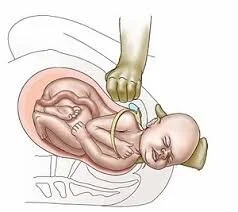Shoulder dystocia is the inability to deliver the fetal shoulders after delivery of the head with normal obstetric maneuvers. It occurs with approximately <0.3-5.0% (depending on source) of all vaginal deliveries. It is neither predictable nor preventable and is an obstetric emergency.
Brachial plexus injuries result from excessive lateral traction on the fetal head while trying to dislodge the anterior shoulder during vaginal delivery. Brachial plexus injuries occur about 15 percent of the time that a shoulder dystocia is encountered. It is estimated that 20 percent of all such brachial plexus injuries are permanent.
Most brachial plexus injuries result from the application of excessive lateral traction to the fetal neck. Brachial plexus injuries are usually caused by downward traction of the brachial plexus during delivery of the anterior shoulder. Brachial plexus injury occur when excessive lateral traction is applied to the fetal neck during cephalic, breech, or caesarian birth.
On rare occasions, brachial plexus injuries have been the result of in utero malpositioning, or the expulsive forces of labor. Typically, such force is the result of excessive lateral traction by a physician.
Etiology may be determined by a process of exclusion. Accordingly, in an effort to determine whether a particular brachial plexus injury was due to in utero malformation, physicians look to determine whether there were uterine anomalies present such as septated uteri or uterine fibroids. Also of note is whether the presentation was transverse lie or whether asynclitism was present. The presence of oligohydramnos is also relevant.
In determining whether a particular injury was the result of the maternal forces of labor, one must determine if there was hyperstimulation of the uterus with large doses of Pitocin. Evidence of extraordinary uterine contractions or a precipitous labor would show on fetal monitor tracings. Further, brachial plexus injury is also often painful and, if the injury occurs before delivery of the head, the heart rate would suddenly accelerate. This, too, would show on fetal monitor tracings.
Excessive lateral traction is most often the cause of a brachial plexus injury. If an injury occurs during a delivery complicated by shoulder dystocia is also consistent with the injury being the product of excessive traction.
Lateral traction must be distinguished from axial traction. During labor, uterine forces are transmitted axially. As a result these forces normally do not produce sufficient lateral deviation of the head from the shoulders to stretch the brachial plexus and cause injury. SThis degree of lateral deviation is more common with uterine maladaptations like transverse lie or asynclitism.
While brachial plexus injuries do occur in the absence of shoulder dystocia, and even in the absence of traction to the fetal head, permanent obstetric brachial plexus injuries are commonly caused by shoulder dystocia-complicated births.
Shoulder dystocia and brachial plexus injury medical expert witness specialties include obstetrics,
maternal-fetal medicine, pediatric neurology, and obstetric anesthesiology.

